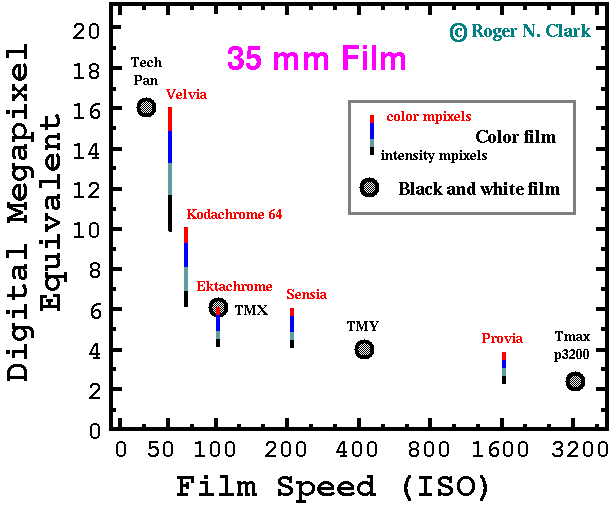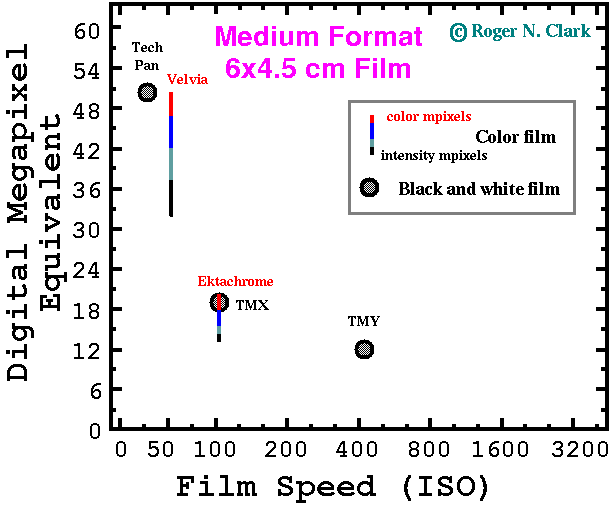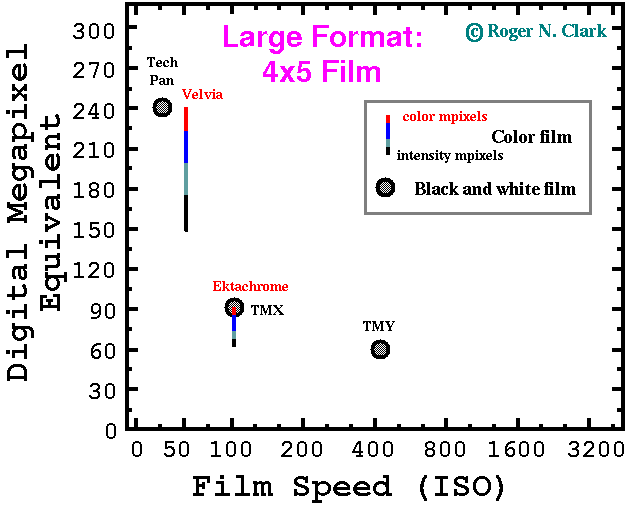ClarkVision.com
| Home | Galleries | Articles | Reviews | Best Gear | Science | New | About | Contact |
Film versus Digital Information
by Roger N. Clark
| Home | Galleries | Articles | Reviews | Best Gear | Science | New | About | Contact |
by Roger N. Clark
Introduction
It is often asked if digital cameras meet or exceed the imaging quality of film. Often the discussion about this issue is heated with both sides claiming their point of view is right. Is there a clear answer? In the experiments I've done, using a variety of films and digital sensors, my data and test results show quite a range of answers.
On this page I present the synthesis of my testing results concerning image detail. Also important in an image is the intensity detail. For example, can consumer digital cameras record the intensity range and small intensity differences comparable to, or even better than film? I will not address that issue here, but intend to investigate that topic in the future.
The detailed presentation of test targets, sampling and side by side comparison of scanned film and digital camera images are presented at my image detail main page.
From testing image detail, I have derived the following empirical equations that relate film resolution to the equivalent number of pixels a digital camera would need. The digital camera equivalent applies to a monochrome (Bayer) sensor that is common in consumer and pro digital cameras currently on the market. In the following equations lpm1.6 refers to the published film resolution in line pairs per millimeter with a target with a contrast of 1.6.
digital megapixel equivalent (35 mm film) = 10 * (lpm1.6 / 80 lpm)2 (eqn 1)
digital megapixel equivalent (6x4.5 cm film) = 31 * (lpm1.6 / 80 lpm)2 (eqn 2)
digital megapixel equivalent (4x5 film) = 150 * (lpm1.6 / 80 lpm)2 (eqn 3)
digital megapixel equivalent (8x10 film) = 600 * (lpm1.6 / 80 lpm)2 (eqn 4)
Further, for color film, digital Bayer sensors record one color per sensor element (pixel), thus color detail is less and one needs higher numbers of pixels to match the color resolution of film. My research shows about 1.6 times more pixels are needed to record the color detail of film.
Example:
Fujichrome Velvia (both the ISO 50 and ISO 100 velvia) have
an lpm1.6 = 80 lpm. Equation 1 gives 10
megapixels for intensity detail, but color detail would require 16 megapixels.
If you read my image detail pages, note that I used consumer grade cameras and older used large format lenses for my tests. For example, for my Mount Sneffels Reflection test scene, I used a Sigma zoom lens on a Canon Elan camera. For the 4x5 image, I used an old velostigmat uncoated lens. So, I believe the results derived are what most camera users can achieve. The one caveat is that for the fine grained film test, like Fujichrome Velvia, I stop my 35mm lenses to their optimum performance level (usually f/11) and I use a tripod.
In the figures below, the derived digital megapixel equivalent are fuzzy numbers. For example, the Fujichrome Velvia 35mm equivalent is 10 to 16 megapixels. The 10 and 16 are soft. By soft I mean by several megapixels, like 10 meaning 8 to 12, and 16 meaning 14 to 18. You can see what I mean by trying to compare some of my test images yourself.




Back to image detail main page
| Home | Galleries | Articles | Reviews | Best Gear | Science | New | About | Contact |
http://clarkvision.com/articles/film.vs.digital.1
First Published: May, 2002.
Last updated July 26, 2005